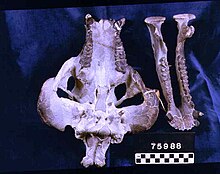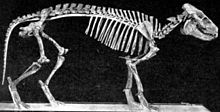Merycoidodontidae
| Merycoidodontidae | ||||||||||||
|---|---|---|---|---|---|---|---|---|---|---|---|---|

Merycoidodon in a drawing by Heinrich Harder |
||||||||||||
| Temporal occurrence | ||||||||||||
| late Eocene to late Miocene | ||||||||||||
| 38 to 5 million years | ||||||||||||
| Locations | ||||||||||||
| Systematics | ||||||||||||
|
||||||||||||
| Scientific name | ||||||||||||
| Merycoidodontidae | ||||||||||||
| Thorpe , 1923 | ||||||||||||
The merycoidodontoidea earlier than Oreodontidae called, are an extinct group of even-toed ungulates , over a period of 30 million years ago from the late Eocene to late Miocene in North and Central America lived. They seem to have emerged from the Agriochoeridae . Since the first Merycoidodontiden were already well developed, one assumes a long, fossil undocumented prehistory. A first adaptive radiation of the Merycoidodontidae took place in the early Eocene, a second in the late Oligocene.
features
They were pig-like, slim to squat, and the size of a rabbit to that of a domestic pig. The lower jaw was high and had a large angle between the body of the lower jaw and the ascending branch of the lower jaw. Their dentition was unreduced and selenodontic . The upper canine and the first lower premolar were opposite, the lower canine was shaped like an incisor, the upper canine and the first premolar were separated by a short diastema . They were four-toed toe walkers with two to five toes on the ground. Merycoidodontids were primarily leaf eaters, with some possibly eating grass or both.
Subfamilies and genera

- Merycoidodontidae
- Aclistomycterinae
- Oreonetinae
- Leptaucheniinae
- Miniochoerinae
- Merycoidodontinae
- Promerycochoerinae
- Merycochoerinae
- Eporeodontinae
- Ticholeptinae
- Merychyinae
- "Ustatochoerinae"
- "Brachycrurinae"
literature
- Donald R. Prothero, Scott E. Foss (Eds.): The Evolution of Artiodactyls. Johns Hopkins University Press, Baltimore MD 2007, ISBN 978-0-8018-8735-2 .
Web links
- The Paleobiology Database: Merycoidodontidae (oreodont)

